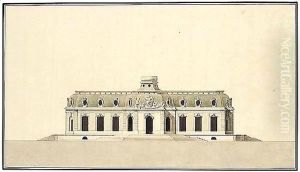Etienne Cherubin Lecomte Paintings
Étienne Chéron (also known as Etienne Cherubin Lecomte) was a French painter, engraver, and illustrator born on October 13, 1701, in Paris, France. His artistic career unfolded during the Rococo period, which was characterized by its ornate and highly decorative qualities, and was prominent in the early to mid-18th century. Chéron was noted for his classical style, which was influenced by the works of artists from earlier periods, such as the Renaissance and Baroque.
Chéron's father, Louis Chéron, was also a painter, and it was under his tutelage that Étienne first studied the arts. The Chéron family had a significant artistic legacy, with multiple members engaged in various creative professions. Étienne's early exposure to the arts through his family undoubtedly shaped his career path and skill set.
As Étienne Chéron matured as an artist, he became known for his fine line engravings and book illustrations. His works were often reproductions of famous paintings, which were in demand for the reproduction in books and for collectors who could not afford original paintings. Chéron's engravings were celebrated for their clarity and attention to detail. He also created original compositions, which reflect the ideals of balance and elegance that were central to Rococo aesthetics.
Although the exact details of Chéron's career and contributions are not as widely documented as those of some of his contemporaries, it is clear that he was an accomplished artist of his time. His style was harmonious with the tastes of the French nobility and the intellectual elite, who were his primary patrons.
Étienne Chéron passed away on May 1, 1771, in Paris. His legacy, while not as prominent as that of some other artists of the era, is preserved through the engravings and illustrations that continue to be appreciated by art historians and collectors for their representation of the Rococo period's artistic sensibilities.
